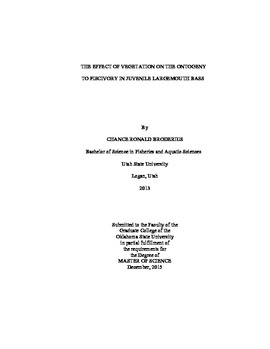| dc.contributor.advisor | Shoup, Daniel E. | |
| dc.contributor.author | Broderius, Chance Ronald | |
| dc.date.accessioned | 2016-09-29T18:44:12Z | |
| dc.date.available | 2016-09-29T18:44:12Z | |
| dc.date.issued | 2015-12-01 | |
| dc.identifier.uri | https://hdl.handle.net/11244/45342 | |
| dc.description.abstract | Largemouth Bass (Micropterus salmoides) are an economically important gamefish species in North America and as such are a focal species for managers. A frequent bottleneck to their recruitment is overwinter survival in their first year of life. Early ontogeny to piscivory provides increased overwinter survival through growth and accumulation of lipids. This ontogeny is slowed by dense and complex vegetative habitats according to anecdotal field evidence. I chose to address two issues: 1) does vegetation density affect the foraging return of piscivorous juvenile Largemouth Bass? 2) Does vegetation density affect the timing of the ontogeny to piscivory in juvenile Largemouth Bass? To answer objective 1) I conducted foraging trials using piscivorous juvenile Largemouth Bass and Juvenile Fathead Minnows (Pimephales promelas) in eight treatments of varying simulated vegetation densities (0, 125, 250, 500, and 1,000 stems/m2) and complexities (simple and complex). Piscivorous Largemouth Bass consumed the most Fathead Minnows in the 125 stems/m2 simple treatment and the least in the 0 stems/m2 treatment. Indicating that juvenile Largemouth Bass forage least efficiently on Fathead Minnows in habitats with no complexity. To answer objective 2) I conducted enclosure experiments across 5 weeks of the typical time frame (mid-summer) that juvenile Largemouth Bass would transition to piscivory. Thirty-two enclosures were constructed across two 0.10 hectare ponds and treated with four stem densities of simulated vegetation (0, 50, 250, and 500 stems/m2). Three juvenile Largemouth Bass and 30 juvenile Bluegill (Lepomis macrochirus) were added to each enclosure. All fish were sampled twice per week. Largemouth bass growth was measured as total length (mm) and diets were collected via gastric lavage. Bluegill densities were manipulated to stay consistent. It was found that Largemouth Bass switched to piscivory during the second week in the 0, 50, and 500 stems/m2 treatments but did not completely switch in the 250 stems/m2 treatment. Growth mirrored this pattern where Largemouth Bass grew less in the 250 stems/m2 treatment. Differing results in these two experiments suggest that vegetation density does affect the foraging rate and subsequent ontogeny to piscivory in juvenile Largemouth Bass. However, it has an interactive effect with available fish prey species. | |
| dc.format | application/pdf | |
| dc.language | en_US | |
| dc.rights | Copyright is held by the author who has granted the Oklahoma State University Library the non-exclusive right to share this material in its institutional repository. Contact Digital Library Services at lib-dls@okstate.edu or 405-744-9161 for the permission policy on the use, reproduction or distribution of this material. | |
| dc.title | Effect of Vegetation on the Ontogeny to Piscivory in Juvenile Largemouth Bass | |
| dc.type | text | |
| dc.contributor.committeeMember | Long, James M. | |
| dc.contributor.committeeMember | Dzialowski, Andrew R. | |
| osu.filename | Broderius_okstate_0664M_14312.pdf | |
| osu.accesstype | Open Access | |
| dc.description.department | Natural Resources and Ecology Management | |
| dc.type.genre | Thesis | |
